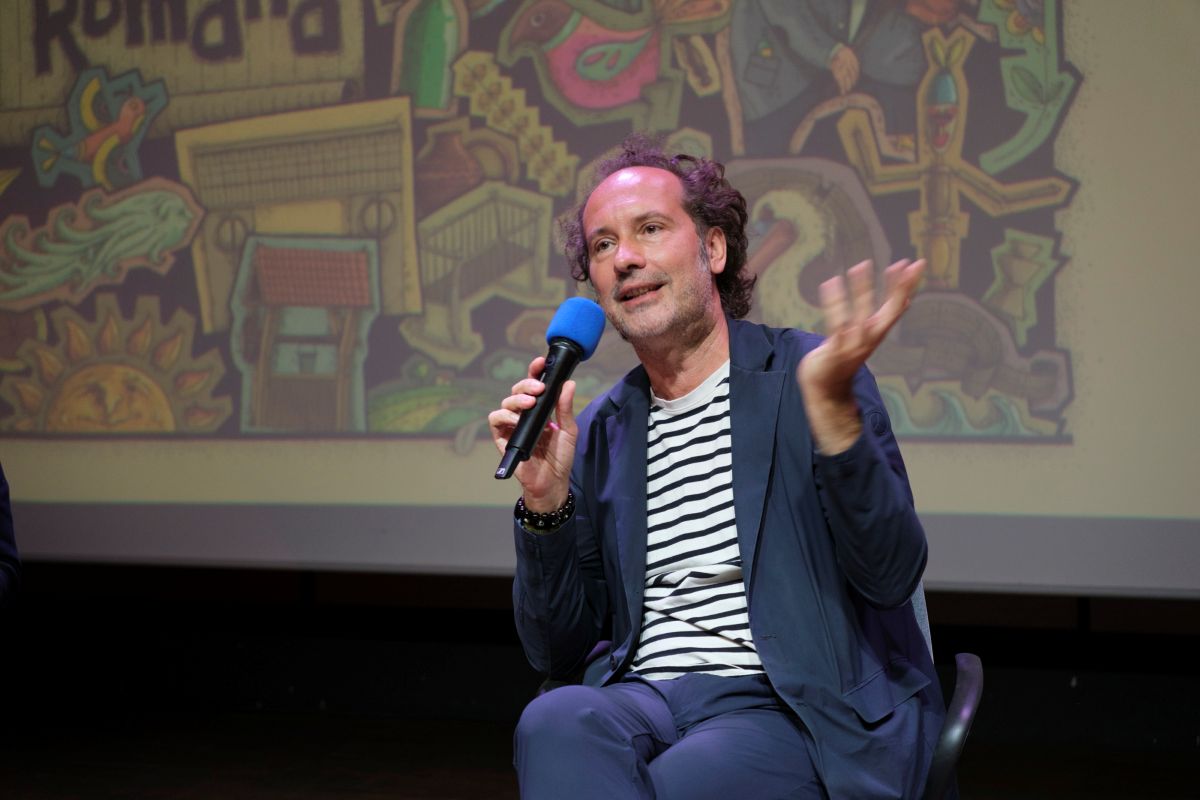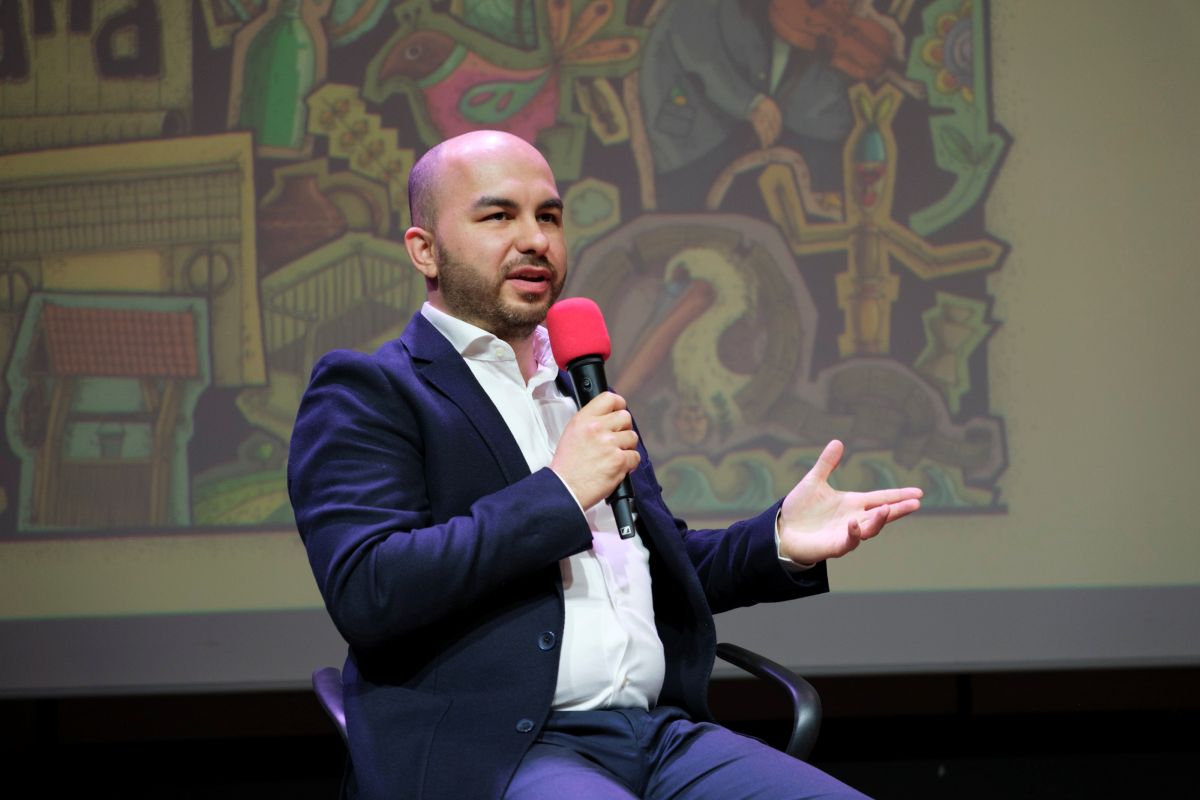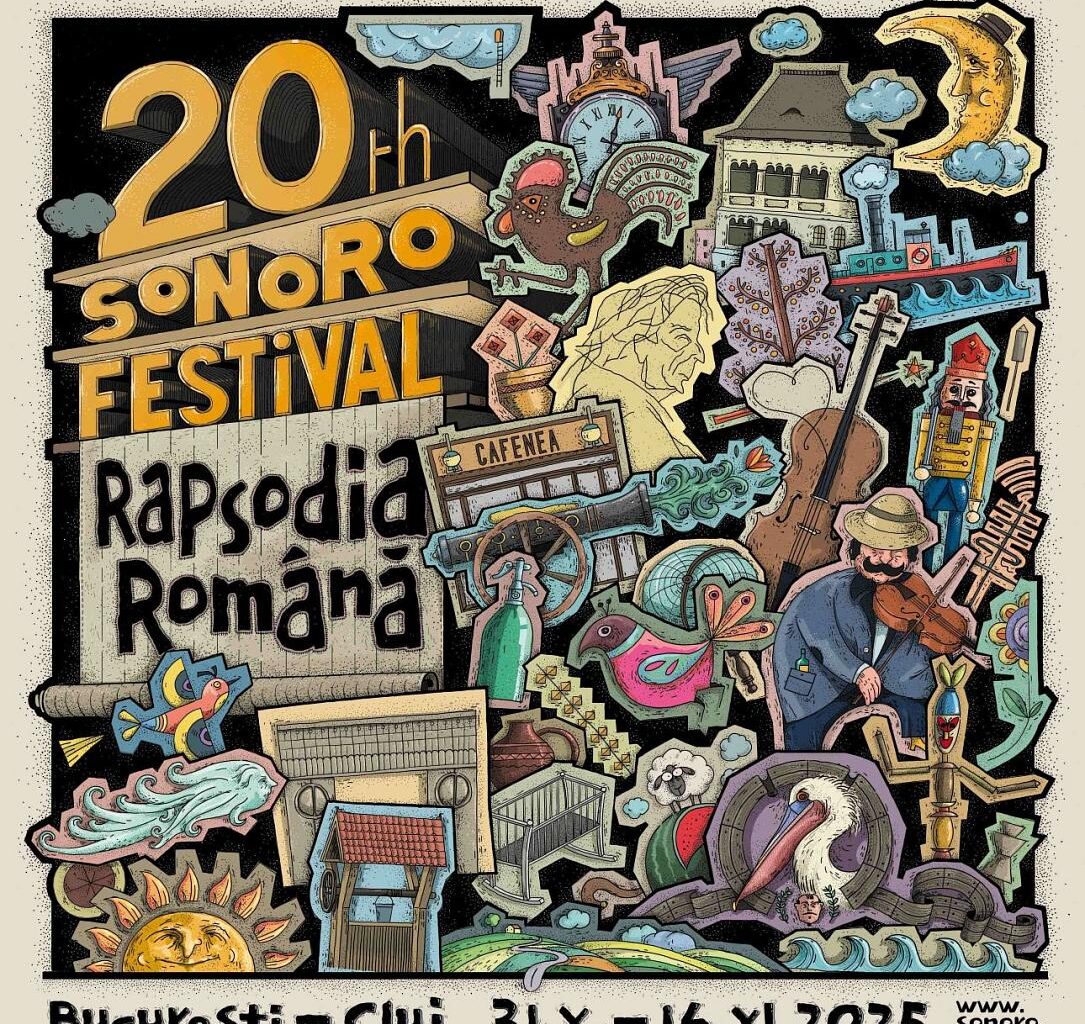The program of the 20th edition, titled Romanian Rhapsody, features 20 concerts in Bucharest and Cluj, weaving together an eclectic and playful blend of references to Romanian culture, spanning music, history, and geography. From well-known figures to subtle nods and deep cuts, it also speaks to an audience familiar with the country’s recent past, while introducing new ideas and music pieces.
It is meant as a musical celebration of the country “that offered us this space where we could make good music, conquer venues, dream, create, experiment, make mistakes,” SoNoRo founder Răzvan Popovici, explained at a press conference announcing the event.
“Romania allowed us to develop a festival of a spirit rarely seen in Europe, because it is truly a festival. We all know that festivals can be a series of concerts, happenings. I believe a festival is a space where both the public and the musicians experience something very special. I’ve noticed that what we have managed to galvanize during the festival is something very personal. And I am very pleased we did.”
A part of the program is taken up by works by Romanian composers. Not only George Enescu, the celebrated musician whose Romanian Rhapsodies are echoed in the 2025 edition title, but also Ciprian Porumbescu, Mihail Jora, Dinu Lipatti, Dan Dediu, Anatol Vieru, and Stan Golestan.
Enescu’s Octet for Strings in C major, performed at SoNoRo’s first edition 20 years ago, has been included in this year’s program again. “Twenty years ago, when we played The Octet, few knew the piece. Now, very many extraordinary musicians have added it to their repertoire, and playing it has become ‘business as usual’,” Popovici noted, also pointing to the work to promote the Romanian composer’s music done by the Enescu Festival, which recently ended in Bucharest.

Violist Răzvan Popovici, the founder and executive director of SoNoRo
The musicians of this edition
A highlight of this year’s edition will be the concert by Amsterdam Klezmer Band, whose music mixes klezmer, balkan, ska, jazz, gipsy, oriental, and hip hop. In attempting to create a portrait of Romania, the festival has chosen to highlight the tradition of klezmer music to honor the Jewish community that once lived in Moldova.
Meanwhile, the public in Cluj will get to listen to the Budapest-based Franz Liszt Chamber Orchestra at a concert taking place at the Reformed Church. The program includes works by Pēteris Vasks and George Enescu, performed by violist Răzvan Popovici, pianist Diana Ketler, and the Hungarian ensemble.
Also from the Hungarian capital, violinist-couple Katalin Kokas and Barnabás Kelemen, the artistic directors of the Festival Academy Budapest (FAB), will be part of the festival’s Gate of the Kiss concert, with a program of works by Samuel Barber, Francis Poulenc, Béla Bartók, Marcel Mihailovici, and Edward Elgar. It will be the third concert where SoNoRo is collaborating with FAB, following two scheduled for October in Berlin and Budapest as part of their anniversary SoNoRo On Tour, which began last November at Teatro Colón in Buenos Aires and will conclude in December at Carnegie Hall in New York.
Performing for the first time at SoNoRo will be Ukrainian violinist Diana Tishchenko, the winner of the 2018 International Long Thibaud Crespin Competition in Paris, the Finnish-American violinist Elina Vähälä, also the artistic director of the Naantali Music Festival, and German pianist Alexander Lonquich. American violist Blythe Teh Engstroem will return to the festival, as will German cellist Justus Grimm and Swedish cellist Frans Helmerson. Also performing at the festival will be South Korean cellist Sung-Won Yang, violinist Mihaela Martin, pianist Cristian Budu, accordionist Radu Rățoi, mezzosoprano Roxana Constantinescu, and the 2025 SoNoRo fellows.
The educational program SoNoRo Interferences has offered more than 570 scholarships to young talents in Romania since its establishment. Among them are rising stars who took part in the program during their teens, such as cellist Andrei Ionita, the 2015 winner of the first prize of the 2015 International Tchaikovsky Competition, violinist Valentin Serban, winner of the violin section of the 2020/2021 George Enescu International Competition, cellist Ştefan Cazacu, awarded at the 2021 George Enescu International Competition, pianists Dragoș Dimitriu, Mihai Ritivoiu, and Adela Liculescu, or violinist Ioana Goicea.

Pianist Dragoș Dimitriu, SoNoRo’s development director
From audience to community
The tickets for this year’s SoNoRo are already on sale at prices slightly lower than those of the previous year. The decision to lower the prices was made despite the increase in taxes, given the current economic situation, with the aim of making the festival more accessible, especially since it’s an anniversary year. The goal wasn’t necessarily to attract a larger audience, as attendance has been stable, but to respond to feedback about high ticket costs and ensure that quality music and culture remain accessible to everyone, the organizers said.
It aligns with the festival’s ethos of bringing chamber music to audiences across Romania and further developing the community surrounding its platform of projects.
The festival has previously organized editions in various cities across the country and has found a second home in Cluj, in addition to Bucharest. Through its programs, SoNoRo has highlighted a wealth of architectural heritage and added numerous venues in the country to the cultural events map. What makes a venue appropriate for a chamber music concert? “Usually, we look into the history of the place, but I have to mention that it doesn’t necessarily have to be a historic space. We also played in industrial spaces. If we play in a historic place, we’ll have a specific program for that, which combines with the nature around it, with the people who tend to it, and so on. If we play in an industrial space, of course, the program will be completely different, the lighting will be different, and the decor will be completely different. We usually choose places that need attention from the audience and other cultural organizers. We put these places on the map where other cultural organizers can see them and have access to them,” Dragoș Dimitriu, the festival’s development director, explains.
Outside of the festival, SoNoRo runs a yearly summer series of concerts hosted in heritage buildings across the country, SoNoRo Conac, and a yearly festival dedicated to Transylvania’s traditions and architectural heritage. These are two of the initiatives that are part of the cultural platform developed under the SoNoRo brand, besides the educational projects for children and young musicians, and the project orchestra SoNoRo strings.
“The community of the festival is divided into two parts. The artistic part, with the young students and the artists we bring from outside of the country, and the artists we also bring from Romania to other countries, but also our community within the audience, which has developed in many cities in Romania, like Cluj, Timișoara, Brașov, Sibiu, Bucharest, and Iași. And I think that is one very important aspect. We have created this community that didn’t exist before. And which is very much focused on chamber music and on our, let’s say, creative width,” Dimitriu says.
He credits the development of a dedicated public to how the festival is presented. “I think it’s presenting it another way so most of the people find the access, because we hear often ‘I don’t go to the opera, I don’t go to a concert because it’s too stiff and I feel like I’m uncomfortable there’ Well, we have created this atmosphere where we tell everyone that our tone of voice is a warm one, it’s very welcoming, you don’t need to be prepared in any way to join a SoNoRo concert, you can simply come as you are.”
The festival is known for blending insights from architecture, film, literature, psychology, and theater into its musical offerings, as captured in the themes of its editions, each an invitation for a fresh way of engaging with classical music. The public has followed suit, and the organizers have seen them become more knowledgeable and attentive, recognizing differences in interpretation or paying attention to other details, such as the particular size of an instrument compared to another.
“I was quite surprised to hear some audience members telling us about the interpretations. For example, we had the same quartet by Beethoven, which we played maybe 15 years ago, and now they said, ‘ah, but this interpretation was quite different, and now the second movement was a little bit slower, or the first movement was a little bit faster,’ which means that they actually have educated themselves, so their ear has changed quite a bit.”
For this year’s edition of the main festival, the organizers expect a public of 3,500-4,000 people, which is the maximum capacity of the venues where it takes place. The other SoNoRo programs gather additional public, as does the SoNoRo Kids project, which targets 1,200 children in different schools. The latter is an educational endeavor that is also meant to foster a future audience for classical music.
“We have German-speaking schools, Hungarian-speaking schools, and Romanian schools as well, which is quite nice because we address different sectors and grow the audience as well. The idea is to plant the seeds in different educational systems, so we have the generation of tomorrow. The European Union is constantly talking about audience development, but what are we actually doing about it? So, we decided to take it into our own hands and create this project,” the festival’s development director explains.
Many may drift away from classical music after school, opting for other types of music, but later reconnect, recalling their early experiences with SoNoRo.
“But then 10 years later, let’s say after they finish university, they come back and they say, ‘I remember, I used to go to that concert, it was Sonoro, it was chamber music.’ I’ve heard this story hundreds of times, from different people, and especially parents, which I think is quite nice. They feel welcome, as I’ve said before.”
Looking back on SoNoro’s 20-year history, he says no edition is like the other. “I think that’s the most beautiful part of event organizing. You don’t have a certain pattern that you have to follow, and everything will happen the same. No, everything will go crazy. This is the main lesson learned: nothing that you have planned at home will happen the same when you reach the venue.”
As for what comes next, following on with existing projects in cultural management and education: “developing our orchestra and adding more music to the educational process in schools in Romania. I think that has to be one of our main purposes for the future – education, education, education.”
SoNoRo takes place between October 31 and November 16 in Bucharest and Cluj. The program is listed here.
(Photos: Şerban Mestecăneanu, courtesy of SoNoRo)
simona@romania-insider.com
